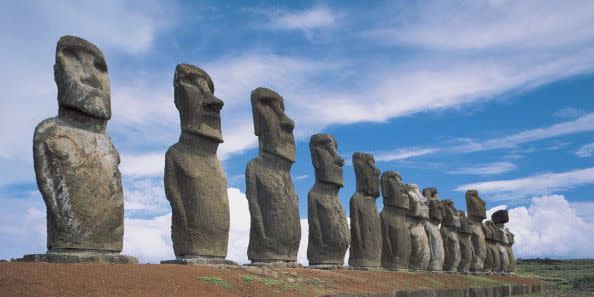A New Statue Suddenly Appeared on Easter Island. That Doesn't Make Sense.

There are more than 1,000 moai statues on Easter Island, representing a key part of the region’s cultural and archeological past.
A new moai, smaller than most, was found in a dried-up lakebed.
The new find raises the potential for additional moai finds in the future.
Just when experts thought they knew every moai on Rapa Nui, otherwise known as Easter Island, a dried-up lakebed kept them on their toes. These statues—largely made of a stone formed from volcanic ash and dust called—pepper the island, with more than 1,000 already found and logged.
Finding a new one came as a surprise. And a bit of a mystery.
“We think we know all the moai, but then a new one turns up, a new discovery, and in this case, in the lake, at the statue quarry,” Terry Hunt, professor of archeology at the University of Arizona, tells Good Morning America. “There have been no moai found in the dry bed or in what was previously a lake, so this is a first.”
And it may not be the last.
As the area undergoes drying, the lakebed in question has given up its moai. And this opportunity may occur again. “Under the dry conditions that we have now, we may find more,” Hunt says. “They’ve been hidden by the tall reeds that grow in the lakebed and prospecting with something that can detect what’s under the ground surface may tell us that there are in fact more moai in the lakebed sediments. When there’s one moai in the lake, there’s probably more.”
The newly discovered moai is also one of the smallest found, leading experts to believe that hidden within these reeds is the potential for a bounty of new moai.
Created by the Rapu Nui people, moai have a mythical legend attached to them and have gained worldwide renown for their appearances. Some believe these moai were given special powers to walk across land and end up in their resting place. Whether or not the legend has legs, there are many theories regarding how these statues moved from building sites to various locations.
While the largest of the statues weighs 86 tons and rises 32 feet tall, most of the moai average about half that size. About 95 percent are carved from the volcanic tuff, but a few are made from basalt. Each one is unique, created by carvers to represent the characteristics of the person it resembled, often a chieftain or key leader.
The finishing touch on moai was the inclusion of special stones for the eyes, not carved or placed until the statue found its home.
Even though experts thought they knew the locations of all of these moai homes, finding this new, small one in the lakebed proves some had remained a complete mystery.
“It’s here in the lake and nobody knows this exists,” Salvador Atan Hito, vice president of Ma’u Henua, the group that oversees the island’s national park, tells Good Morning America, “even the ancestors, our grandparents don’t know [about] that one.”
You Might Also Like
